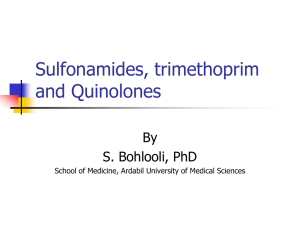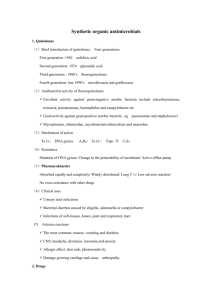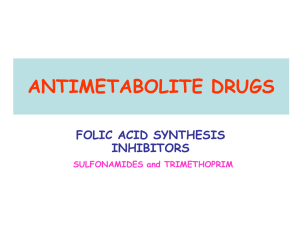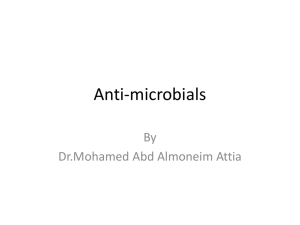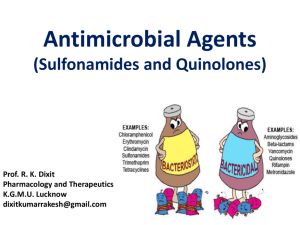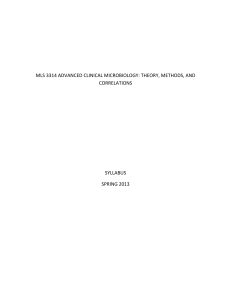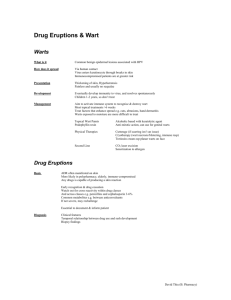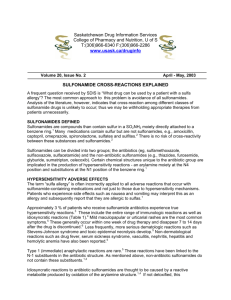Sulfonamides. Synthetic antibacterial agents of various chemical
advertisement
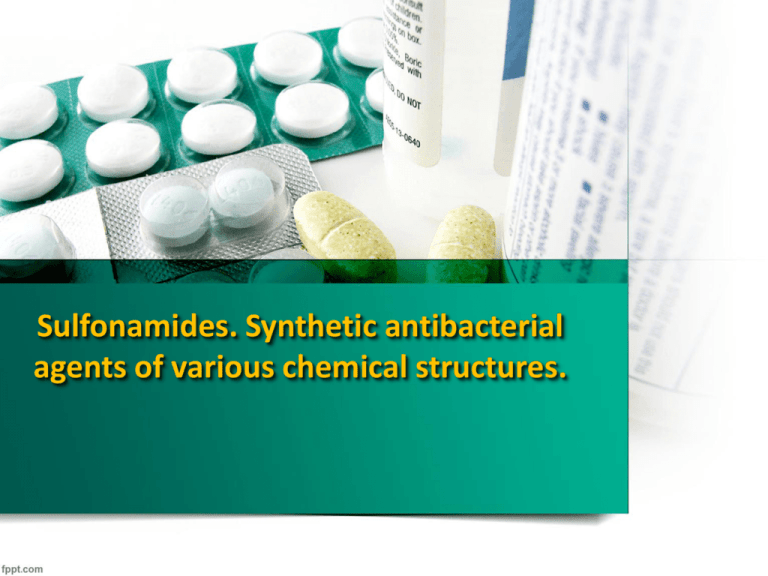
Sulfonamides. Synthetic antibacterial agents of various chemical structures. Sulfonamides can be represented by the following groups . Drugs used to resorbtive action (well absorbed from the gastrointestinal tract) A. Short action sulfadimezin Etazol Sulfazin Urosulfan B. Long-acting sulfapiridazin sulfadimetoksin B. Super-long action sulfalen Drugs that act in the intestinal lumen (poorly absorbed from the gastrointestinal tract) ftalazol Preparations for topical use Sulfatsil sodium Sulfazin silver salt The spectrum of action of sulfonamides is quite wide. It includes mainly the following pathogens: a) bacteria - pathogenic cocci (Gram-positive and Gram-negative), E. coli, agents of dysentery (Shigella), Vibrio cholerae, agents of gas gangrene (Clostridium), anthrax, diphtheria, catarrhal pneumonia, influenza; b) Chlamydia - causative agents of trachoma, ornithosis, inguinal lymphogranuloma c) actinomycetes; d) the simplest - toxoplasmosis pathogen, Plasmodium malaria. Particularly active sulfonamides against pneumococci, meningococci, gonococci, some types of hemolytic streptococci, as well as agents of bacillary dysentery. The mechanism of antimicrobial action of sulfonamides related to their competitive antagonism with para-aminobenzoic acid. The latter includes the structure of dihydrofolic acid, which is synthesized by many microorganisms. In human tissues, it does not, as these are already finished fabric disposed dihydrofolate than probably explains the selective action of the antimicrobial sulphonamides. Due to its chemical similarity to para-amino benzoic acid sulfonamides prevent its inclusion in the dihydrofolate. In addition, they competitively inhibit the digidropteroatsintetazy. Violation of dihydrofolic acid synthesis reduces the formation of tetrahydrofolic acid from it, which is necessary for the synthesis of purine and pyrimidine bases. As a result inhibits the synthesis of nucleic acids, whereby the growth and proliferation of microorganisms inhibited (bacteriostatic effect). With prolonged use of sulfonamides to them gradually develop resistance of microorganisms. It is suggested that this may be due to an increase in the intensity of synthesis of dihydrofolic acid by microorganisms. Keep in mind that there is resistance to all sulfonamides (ie crossresistance). Sulfonamides FOR resorbtive action Drugs in this group rapidly and completely absorbed from the gastrointestinal tract. Sulfonamides partly bound to plasma albumin. Distributed to all tissues, including pass through the blood-brain barrier, placenta, accumulate in the serous cavities of the body. The main way of converting sulfonamides in the body - acetylation (at N4), which occurs in the liver. Formed in this connection have no antibacterial activity. Some acetylated less soluble than the starting sulfonamide and may cause the formation of crystals in the urine (crystalluria). The degree of acetylation of different drugs varies. Least acetylated urosulfan, sulfatsil sodium etazol. You mined-sulfonamides and their metabolites mainly by the kidneys by filtration. Part sulfonamides undergoes reabsorption. Small amounts of substances derived intestines, sweat and salivary glands. Sulfonamide intended for resorbtive action different advantageously duration antibacterial effect. Preparations are well soaked action short and relatively quickly stand out. With their enteral administration maximum plasma concentrations are 2-3 hours. To maintain bacteriostatic concentrations of prescribers in 4-6 hours. Sulfonamides of short actions most often the use, form a sulfadimesine (sulfamethazine) etazol (sulfaethyltiadiasole) sulfazin (sulfadiazine) urosulfan (sulfakarbamide). This group is streptocid (streptocid white, sulfonamides). Currently, however, streptocid almost never used because it is less active and more likely than other sulfonamides, causes side effects. For long-acting drugs are sulfapiridazin (Sulfamethoxypyridazine, spofadazin) and sulfadimetoksin (madribon, madroksin). They are well absorbed from the gastrointestinal tract, but slow output. Maximum concentration in the blood plasma determined after 3-6 hours. Long term preservation of the body bacteriostatic concentrations of drugs appears to depend on their effective reabsorption in the kidney. Can make a difference and expressed the degree of binding to plasma proteins (eg, for sulfapiridazina it corresponds to approximately 85%). Thus, when using long-acting drugs are stable in the body substance concentration. This is an advantage drugs in antibiotic therapy. However, if you experience side effects, long-term effect plays a negative role, since the forced cancellation of substances should take a few days before the end of his action. Note also that the concentrations and sulfapiridazina sulphadimethoxin cerebrospinal fluid is low (5-10% of the concentration in blood plasma). This is different from sulfonamides short steps that build up in the cerebrospinal fluid in fairly large quantities (50-80% of the plasma concentration). Assign sulfapiridazin and sulfadimetoksin 1-2 times a day. Drug action is extremely long sulfalen (kelfizin, sulfametoksipirazin), which in bacteriostatic concentrations retained in the body up to 1 week. According to the antimicrobial activity of sulfonamides significantly inferior to antibiotics, so their scope is limited. They are prescribed mainly in case of intolerance of antibiotics or of addiction to them. Sulfonamides often combined with certain antibiotics. Sulfonamides to resorptive action used for cocci infections, especially in meningococcal meningitis, respiratory diseases, with urinary and biliary tract, and others. For the treatment of urinary tract infections (pyelonephritis, pyelitis, cystitis, particularly shown urosulfan which rapidly excreted by the kidneys, mainly unchanged (i.e., in an active form) in the urine during this generates high concentrations. No negative impact on renal function urosulfan almost no effect. Long-acting drugs most appropriate to use for chronic infections, and for prevention of infection (such as postoperative period-rations). At resorptive action sulfonamides cause a lot of side effects. In their application can be observed dyspeptic symptoms (nausea, vomiting), headache, weakness, disorders of the central nervous system lesions of blood (hemolytic anemia, thrombocytopenia, methemoglobin formation). Crystalluria is possible. The probability of crystals in the kidney may be reduced by administration of large volumes of liquids, especially alkali (as the acidic environment favors precipitation of sulfonamides and their acetylated derivatives). Allergic reactions are relatively rare, but nevertheless they sometimes occur and their severity may vary. There are skin rash, fever, and sometimes hepatitis, agranulocytosis, aplastic anemia. A history of allergic reactions to sulfonamides is a contraindication to their reuse. Sulfonamides in operation in the intestinal lumen The main difference between these products is their poor absorbability from the gastrointestinal tract, intestinal lumen so their concentrations are high. The most commonly used ftalazol (ftalilsulfatiazol, talisulfazol). Drug absorbed from the gut to an insignificant degree. The urine is found only 5% of the administered substance. Antimicrobial effect ftalazol develops after cleavage of phthalic acid (from N4) and the release of amino groups. As a result, effective eye-catching at the same time norsulfazol. Ftalazol used in the treatment of intestinal infections - bacillary dysentery di, enterocolitis, colitis, for the prevention of intestinal infection in the villageleoperatsionnom period. Considering that the microorganisms in these diseases are located not only in the lumen but also in the bowel wall, is useful to combine ftalazol well absorbed from sulfonamides (sulphadimezin etazola et al.). Ftalazol often combined with antibiotics (e.g., tetracycline). Take it every 4-6 hours. Ftalazol Moved well. Toxicity him low. Application ftalazol desirable to combine with B vitamins This is useful in connection with the suppression of ftalazolom growth and reproduction of E. coli involved in the synthesis of these vitamins. For the treatment of intestinal infections, and use a number of other poorly absorbed drugs - sulgin (sulfaguanidine) ftazin. Sulfonamides for local use Sulfonamides used topically for the treatment and prevention of eye infections. For this purpose, the most commonly used water-soluble sodium sulfatsil-. It is quite effective and does not irritate. It is used for the treatment and prevention of gonorrheal eye disease in neonates and adults, conjunctivitis, blepharitis, corneal ulcers and others. Sulfonamide can be used in wound infection (wound typically by dusting). It should be borne in mind that in the presence of pus, wound discharge, necrotic masses containing large amounts of para-amino benzoic acid, sulfonamides little or ineffective. They should only be used after primary treatment of wounds or in a "clean" wounds. Sulfazin synthesized silver salt (Sulfargin), which has in its molecule an atom of silver. The drug is used only locally for burn wounds. Is released from the drug enhances the antimicrobial action of silver Sulfazin and promotes healing of wounds. Included in the ointment "Sulfargin." Combined preparation sulfonamides with trimethoprim Of interest is the combination of sulfonamides with drugs that are inhibiting dihydrofolate reductase, blocking the passage dihydrofolic acid to tetrahydrofolic. These substances include trimethoprim. The inhibitory effect of such a combination, shown at two different stages of the biosynthesis of nucleic acids prekurzorov, significantly increases the antimicrobial activity the effect is bactericidal. The direction of action of sulfonamides and trimethoprim. Produced drug Bactrim (Biseptol, cotrimoxazole, Septrin), containing trimethoprim and sulfamethoxazole. It possesses high antibacterial activity. Has a bactericidal effect. Is well absorbed from the gastrointestinal tract. The maximum concentration in plasma determined after 3 hours. The duration of effect of 6-8 h. Provided both components baktrima in the kidneys. When using Bactrim there are various side effects. The most frequent dyspepsia nausea, vomiting, anorexia, diarrhea) and allergic skin reactions (erythematous rash, hives, itching). May oppression blood (leukopenia, agranulocytosis, thrombocytopenia, megaloblastic anemia, and others.). Sometimes there are violations of the liver and kidneys. There are cases of superinfection (oral candidiasis). Prolonged use baktrima necessary to control the peripheral blood. Bactrim is contraindicated in severe hepatic impairment of kidneys and hematopoiesis. You should not assign his children up to 6 years and during pregnancy. Similar drugs are lidaprim (Sulfametrole + trimethoprim), Sulfaton (contains sulfamonomethoxine and trimethoprim) and poteseptil (sulfadimezin + trimethoprim). Indications, side effects and contraindications for both drugs are the same as for Bactrim. quinolone derivatives Among the first quinolone derivatives, received practical application, is nalidixic acid (nevigramon, blacks). The main range of its actions includes gram-negative bacteria. It is effective against E. coli, Proteus, capsular bacteria (Klebsiella), Shigella, Salmonella. Pseudomonas aeruginosa resistant to nalidixic acid. The mechanism of its antimicrobial action is associated with inhibition of DNA synthesis. Bacterial resistance to the drug develops quite quickly (sometimes a few days after the start of treatment). Of the gastrointestinal drug absorbed well. Chemical transformations exposed about 20% of the administered dose of the substance. Nalidixic acid output (and its metabolites) mainly by the kidneys, resulting in urine are high enough concentration of the substance. The main application - urinary tract infections caused by Escherichia coli, Proteus and other microorganisms sensitive to nalidixic acid. A valuable quality of the preparation is its activity against strains resistant to antibiotics and sulpha drugs. Of the side effects are possible diarrheal disorders, allergic reactions, photodermatosis, transitory visual disturbances (blurred vision, photophobia), headache. Contraindications are diseases with severe liver and kidney function. Should not be prescribed the drug to women in the first 3 months of pregnancy and children under the age of 2 years. In recent years, great attention was attracted by fluoroquinolones - quinolone derivatives having the structure of fluorine atoms. Synthesized a large number of such drugs: ciprofloxacin (tsiprobay), norfloxacin, pefloxacin, lomefloxacin, ofloxacin (tarivid) and others. They are highly active broad spectrum antibacterials of action. It has bactericidal activity against Gram-negative bacteria, including gonorrhea, E. coli, Shigella, Salmonella, Klebsiella pneumoniae, Enterobacter, Haemophilus influenzae, Pseudomonas aeruginosa, mycoplasma, chlamydia and others. With respect to Grampositive bacteria are less active. Fluoroquinolone antibacterial action mechanism is inhibition of bacterial enzymes, topoisomerase II and IV (including gyrase-DNA - topoisomerase II), which disrupts DNA replication and the formation of corresponding RNA-tively. All this hinders the growth and reproduction of bacteria. Fluoroquinolones are well absorbed from the digestive tract. Penetrate into most tissues. Penetrate through the blood-brain barrier in a non-crawled concentrations only certain drugs (ofloxacin, pefloxacin, ciprofloxacin), and then with the inflammation of the meninges. Moderately bound to plasma proteins. Provided mainly kidneys (by filtration and active secretion). They are used for infections of the urinary, respiratory tract, gastrointestinal tract caused by microorganisms sensitive to fluoroquinolones. Addictive microorganisms to fluoroquinolones develops relatively slowly. The side effects observed diarrheal disorders, skin rashes and other allergic reactions, headache, dizziness, insomnia, photosensitivity. Possible superinfection. Overall, however, fluoroquinolones are well tolerated. Contraindicated in pregnant and lactating women, as well as patients under the age of 18 years. One of the important directions in the development of new fluoroquinolones increase the antimicrobial activity of the compounds against Gram-positive bacteria, in particular Streptococcus pneumoniae and other streptococci, and atypical pathogens ana¬erobnye. These drugs include moxifloxacin (aveloks), wherein a high bactericidal activity against streptococci, staphylococci, Listeria, Corynebacterium, and to a lesser extent enterococci. For example, the influence on pneumococci (and bacteroides) moxifloxacin 4-16 times more active than ciprofloxacin and ofloxacin. Note that moxifloxacin effective in infection with Gram-positive bacteria resistant to many other antimicrobial agents. Furthermore, moxifloxacin has high activity against chlamydia, mycoplasma, ureaplasma and anaerobic pathogens. Activity against anaerobes moxifloxacin is at metronidazole, clindamycin and imipenem. The drug is well absorbed from the intestine. The bioavailability of approximately 90%. About 48% bound to plasma proteins. 50% of the substance is metabolized in the liver. Allocated moxifloxacin and its metabolites by the kidneys and the bile into the intestine. Prescribers 1 time per day. Moxifloxacin well tolerated. Side effects mainly ana-logical to those of other fluoroquinolones (no photosensitizing effect). Often marked nausea, diarrhea, dizziness. Among the new fluoroquinolones gatifloxacin also include, gemifloxacin, levofloxacin. All of them are effective when given enterally and have high bioavailability, characterized significant efficacy against gram-positive bacteria while retaining a bactericidal action against Gram-negative bacteria. Very effective against Streptococcus pneumoniae and other respiratory pathogens - Haemophilus influenzae, Moraxella catarrhalis. This contributes to the fact that they accumulate in high concentrations in tissues and fluids of the respiratory organs (in a higher concentration than in serum). Enter them as moxifloxacin, 1 time per day. Synthetic antibacterials different chemical structure The 8-hydroxyquinoline Preparations in this series have antibacterial and antiprotozoal effects. For this group of antimicrobial agents include 5-nitro-8-hydroxy-quinoline - nitroksolin (5-NOC). The drug has a broad spectrum anti-bacterial action. In addition, it has an inhibitory effect on that non-fungi (yeast et al.). Nitroksolin is rapidly absorbed from the intestine. Excreted unchanged in the urine, which accumulates in the bacteriostatic concentrations. Apply nitroksolin urinary tract infections caused by various microorganisms. Appointed interior. Of the side effects are possible dyspeptic symptoms. Keep in mind that when taking nitroksolin urine becomes bright yellow. Nitrofuran derivatives This group of compounds includes many drugs. Some are mainly used as an antiseptic for external use (napri¬mer, furatsilin), others - mainly for the treatment of intestinal infections and urinary tract infections (furazolidone, furadonin, furagin). Importantly, nitrofurans effective against microorganisms resistant to antibiotics and sulfonamides. Furazolidone is used for intestinal infections (bacillary dysentery, paratyphoid, poisoning), as well as Trichomonas coleitis and giardiasis. Putting it inside, vaginally, rectally. May cause dyspeptic symptoms, allergic reactions. An effective drug for the treatment of urinary tract infections is furadonin (nitrofurantoin). Assign it inside. It is rapidly absorbed and excreted by the kidneys in large numbers, where are bacteriostatic and bactericidal concentrations. As furazolidone, it may interfere with appetite, cause nausea, vomiting. Some patients have an allergic reaction. Furagin used for urinary tract infections, as well as locally. In order to reduce side effects while taking nitrofuran derivatives are recommended to drink plenty of blockers of histamine H1-receptor, B vitamins DERIVATIVES QUINOXALINE This group of antibacterial agents represented hinoksidinom and Dioxydinum. They have a broad spectrum of antimicrobial activity, including Proteus vulgaris, Pseudomonas aeruginosa, pathogenic anaerobes et al. Are active against bacteria resistant to other chemotherapeutic agents. Apply with heavy inflammatory processes. Assign only adults with hospital treatment under medical supervision. Drugs are quite toxic and often cause side effects. Of the latter may dyspepsia, headache, dizziness, chills, muscle twitching and others. oxazolidinone A new class of active antimicrobial agents are oxazolidinones. The first preparation in this group linezolid (Zyvox) is effective against a broad spectrum of pathogens - aerobic Gram positive bacteria, some gram-negative bacteria and many anaerobes. Linezolid is also used for infections caused by resistant bacteria to other drugs. The mechanism of antimicrobial activity is associated with inhibition of initial protein synthesis steps. It is suggested that in the context of the whole organism preparation bactericidal effect (in vitro - bacteriostatic). Effective with enteral and parenteral administration. Designed primarily for the treatment of severe infections caused by Gram-positive bacteria.
